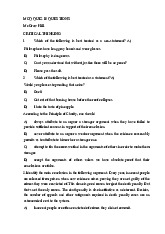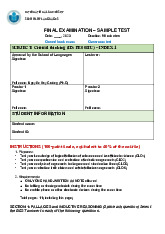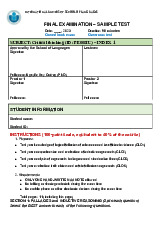




















Preview text:
CRITICAL THINKING
Course code: PE008IU (3 credits) Instructor: TRAN THANH TU Email: tttu@hcmiu.edu.vn 1 Chapter 11: Inductive Reasoning 2 Introduction to Induction
Another way to identify inductive arguments
is look for their common patterns: Inductive generalization Statistical arguments Arguments from analogy Causal arguments Predictive arguments Arguments from authority 3 1. Inductive Generalizations
An inductive generalization is an argument that
relies on characteristics of a sample population to
make a claim about the populations as a whole.
In other words, it is an argument that uses
evidence about a limited number of people or
things of a certain type (the sample population) to
make a claim about a larger group of people or
things of that type (population as a whole) 4 1. Inductive Generalizations
All the bass Hank has caught in the Susquehanna River
have weighted less than one pound.
So, most of the bass in the Susquehanna River weigh less than one pound. The sample population is in the Susquehanna River.
The population as a whole is all the bass in the Susquehanna River.
All the bass Hank has caught in the Susquehanna
River have weighted less than one pound. So, ma so n m y
e of the bass in the Susquehanna River stronger weigh less than one pound. 5 1. Inductive Generalizations
In understanding inductive generalizations:
Identify the sample population and the population as a
whole (i.e. the population that the generalization is
about) in an inductive generalization.
A good inductive argument should reach a conclusion
that is appropriate to the evidence offered in the premises.
A more moderate conclusion makes the inference stronger.
An overstated conclusion makes the inference weaker. 6
Evaluating inductive generalizations
In evaluating inductive generalizations, there are three questions we should ask: Are the premises true?
Is the sample large enough?
Is the sample representative or typical of the population as a whole?
An inductive generalization is a good one only if
we can answer "yes" to all three questions. 7 2. Statistical Arguments
A statistical argument argues from premises
regarding a percentage of population to a
conclusion about an individual member of
that population or some part of that population. 8 Example
Only 3 percent of IU are against building the new gymnasium. A is an IU student.
So, A is not against building the new gymnasium. Stronger argument •
Only 3 percent of IU are against building the new gymnasium. • A is an IU student. •
So, A is probably not against building the new gymnasium. 9 Statistical Arguments
Like other inductive arguments, statistical
arguments are evaluated along a continuum of strong to weak.
Statistical arguments that approach 50 percent
may be strong but are to be considered relative unreliable. 10 Reference class
The reference class in the group to which statistics apply.
As a rule, the more specific the
reference class is, the better the argument is. 11 3. Induction and analogy What is an analogy?
An analogy is a comparison of things
based on similarities those things share. Ex: My love is like the sun. 12 recall
Fallacy: argument that contains a mistake in reasoning. Fallacies of Relevance (11)
Fallacies of Insufficient Evidence (9)
Arguments in which the premises
Arguments in which the premises,
are logically irrelevant to the
though logically relevant to the conclusion.
conclusion, fail to provide sufficient evidence for the conclusion. Personal Attack
Inappropriate Appeal to Authority Attacking the Motive Appeal to Ignorance Look Who’s Talking False Alternatives Two Wrongs Make a Right Loaded Question Scare Tactics Appeal to Pity Questionable Cause Bandwagon Argument Hasty Generalization Straw Man Slippery Slope Red Herring Weak Analogy Equivocation Begging the Question Inconsistency 8. Weak Analogy (recall) Weak Analogy
It’s the fallacy that results from comparing things that are
not really comparable (overlooking important dissimilarities)
Lettuce is leafy and green and tastes great with a veggie
burger. Poison ivy is also leafy and green. Therefore, poison
ivy probably tastes great with a veggie burger, too.
(X has characteristics a, b, c, and d
Y has characteristics a, b, and c
So, Y probable has characteristic d, too)
1. List all important similarities between the two cases.
2. List all important dissimilarities between the two cases.
3. Decide whether the similarities or dissimilarities are Tip more important. How can we argue by analogy? A has characteristic X B has characteristic X A has characteristic Y
Therefore, B has characteristic Y
A has characteristics X and Y
B has characteristics X and Y A has characteristic Z
Therefore, B has characteristic Z. 15
Evaluating arguments from analogy
A and B are both tall and play basketball. A is also play volleyball.
So, B must also play volleyball. 1. True premise? 2. Relevance?
3. Number of relevance similarities: 2
A, B, C and D are all tall and play basketball.
A, C and D are also play volleyball.
So, B must also play volleyball.
Increase sample size Stronger argument 16
Evaluating arguments from analogy
B must also play volleyball: narrow and specific.
Increase the strength of argument:
Specificity of the conclusion relative to the premises
conclusion should be broader and less specific.
B must have played a game of volleyball at some time.
B may also play volleyball.
B may have played a game of volleyball at some time. 17
Evaluating arguments from analogy Consider: The truth of the premise
The relevance of the similarities
The number of relevant similarities
The relevance of the dissimilarities tips
The number of relevant dissimilarities
The diversity of the sample, especially with increased sample size
The specificity of the conclusion relative to the premises 18
4. Induction and Causal Arguments
One of the most basic, most common, and most
important kind of knowledge we seek is knowledge of cause and effect.
A cause is that brings about a change, that which produces an effect.
Not all causal arguments contain the word “cause”. Causal
terms: produce, is responsible for, affects, makes, changes and contributes to
Such arguments come in two broad types: arguments
about the cause of a single instance and arguments about a general relationship. 19 Evaluating causal arguments single instance
A’s car wouldn’t start this morning, and she hasn’t
replaced the battery since she bought six months ago.
So, it is probably a dead battery that caused the car not to start. general relationship
The Surgeon General has found that there is a strong
link between smoking cigarettes and getting lung cancer.
So, smoking cigarettes causes lung cancer. 20




